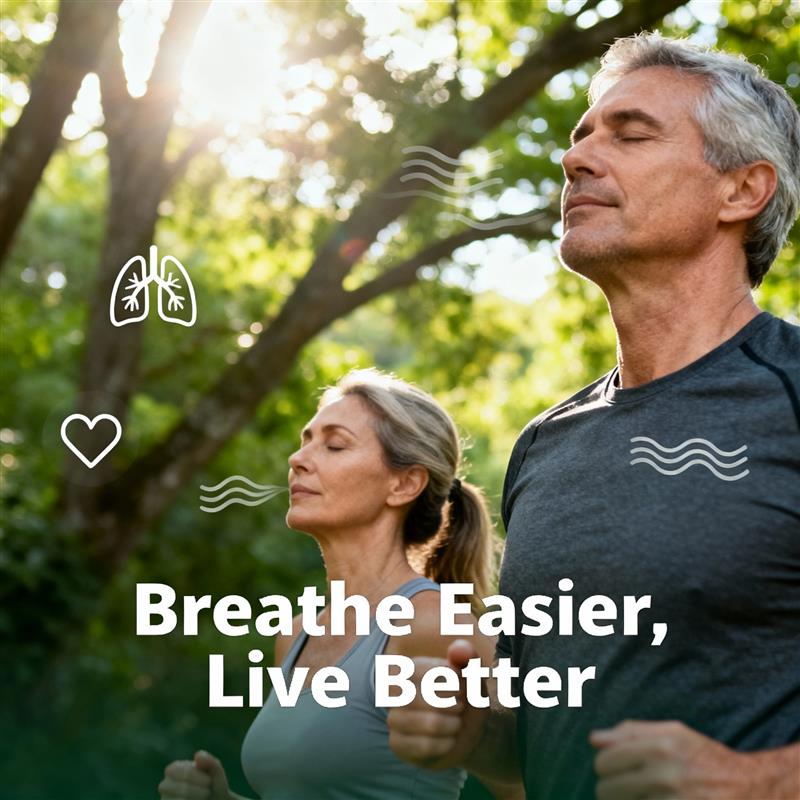
Benefits of Regular Exercise for Better Breathing
Share
In a world where air pollution, stress, and sedentary lifestyles are common, the simple act of breathing deeply and freely can feel like a luxury. But what if the key to better breathing lies in something as accessible as regular exercise?
Whether you're looking to boost your stamina, improve your lung function, or simply enjoy the fresh air a little more, incorporating physical activity into your daily routine can make a huge difference. This blog explores how regular exercise supports better breathing and offers practical tips for getting started.
🫁 How Exercise Supports Better Breathing
1. Improves Lung Capacity
When you engage in aerobic activities like walking, cycling, or swimming, your lungs work harder to meet the increased oxygen demand. Over time, this strengthens your respiratory muscles and improves lung capacity, allowing you to breathe more deeply and efficiently—even at rest.
2. Enhances Oxygen Exchange
Exercise stimulates your cardiovascular system, helping your body transport oxygen more efficiently from your lungs to your muscles. Improved oxygen exchange reduces breathlessness and fatigue, especially during physical exertion.
3. Strengthens Respiratory Muscles
Your diaphragm and intercostal muscles (those between your ribs) play a major role in breathing. Regular physical activity strengthens these muscles, enabling deeper inhalation and more effective exhalation. This can be especially beneficial for people with respiratory conditions like asthma or COPD.
4. Reduces Breathlessness Over Time
If you're short of breath after minimal activity, don't worry—it’s common. But the more you exercise, the more your body adapts. With consistency, your breathing becomes more efficient, and everyday tasks feel less taxing.
5. Clears Airway Blockages
Cardio exercise can help clear mucus from the lungs, especially in people with respiratory issues. Deep breathing during workouts encourages the movement of mucus out of the airways, reducing the risk of infection and improving airflow.
🏃♀️ Best Types of Exercise for Lung Health
Not all exercises impact the lungs in the same way. Here are some of the best activities to support your breathing:
- Walking or Hiking: Low-impact but effective for increasing stamina and lung strength.
- Swimming: Builds endurance while promoting controlled breathing.
- Cycling: Boosts cardiovascular health and challenges respiratory muscles.
- Yoga and Pilates: Focus on breath control, posture, and flexibility.
- Interval Training: Alternating high- and low-intensity activity teaches your lungs to adapt to stress.
🧘♂️ Breathing Exercises That Complement Physical Activity
Pairing regular exercise with breathing techniques can greatly enhance lung efficiency. Try these:
- Pursed-Lip Breathing: Inhale through your nose, exhale slowly through pursed lips.
- Diaphragmatic (Belly) Breathing: Focus on expanding your abdomen as you breathe.
- Box Breathing: Inhale for 4 counts, hold for 4, exhale for 4, and hold for 4.
These techniques calm the nervous system and strengthen your lungs, especially when practiced daily.
🛡️ Who Benefits the Most?
- Asthma and COPD Patients: With medical approval, regular activity can reduce symptoms and improve quality of life.
- Office Workers: Long hours of sitting can restrict lung expansion—exercise keeps the lungs working optimally.
- Older Adults: Maintaining mobility and respiratory strength is crucial for independence and vitality.
🧠 Mental Health and Breathing: A Hidden Link
Exercise isn’t just good for your lungs—it also reduces stress, anxiety, and depression. Stress can cause shallow breathing or hyperventilation. Physical activity promotes relaxed, rhythmic breathing that improves both mental and respiratory well-being.
✅ Tips for Safe and Effective Breathing During Exercise
- Warm up and cool down to prevent breathing shocks.
- Breathe through your nose as much as possible to filter and warm air.
- Stay hydrated to keep airways moist.
- Don’t push through breathlessness—rest when needed.
🚀 Conclusion: Breathe Easier, Live Better
Improving your breathing doesn’t require fancy equipment or extreme workouts—just a commitment to move more, breathe deeply, and stay consistent. Whether you're climbing stairs, doing yoga, or going for a brisk walk, every breath you take during exercise is an investment in your long-term health.
So lace up your sneakers, take a deep breath, and get moving—your lungs will thank you!
